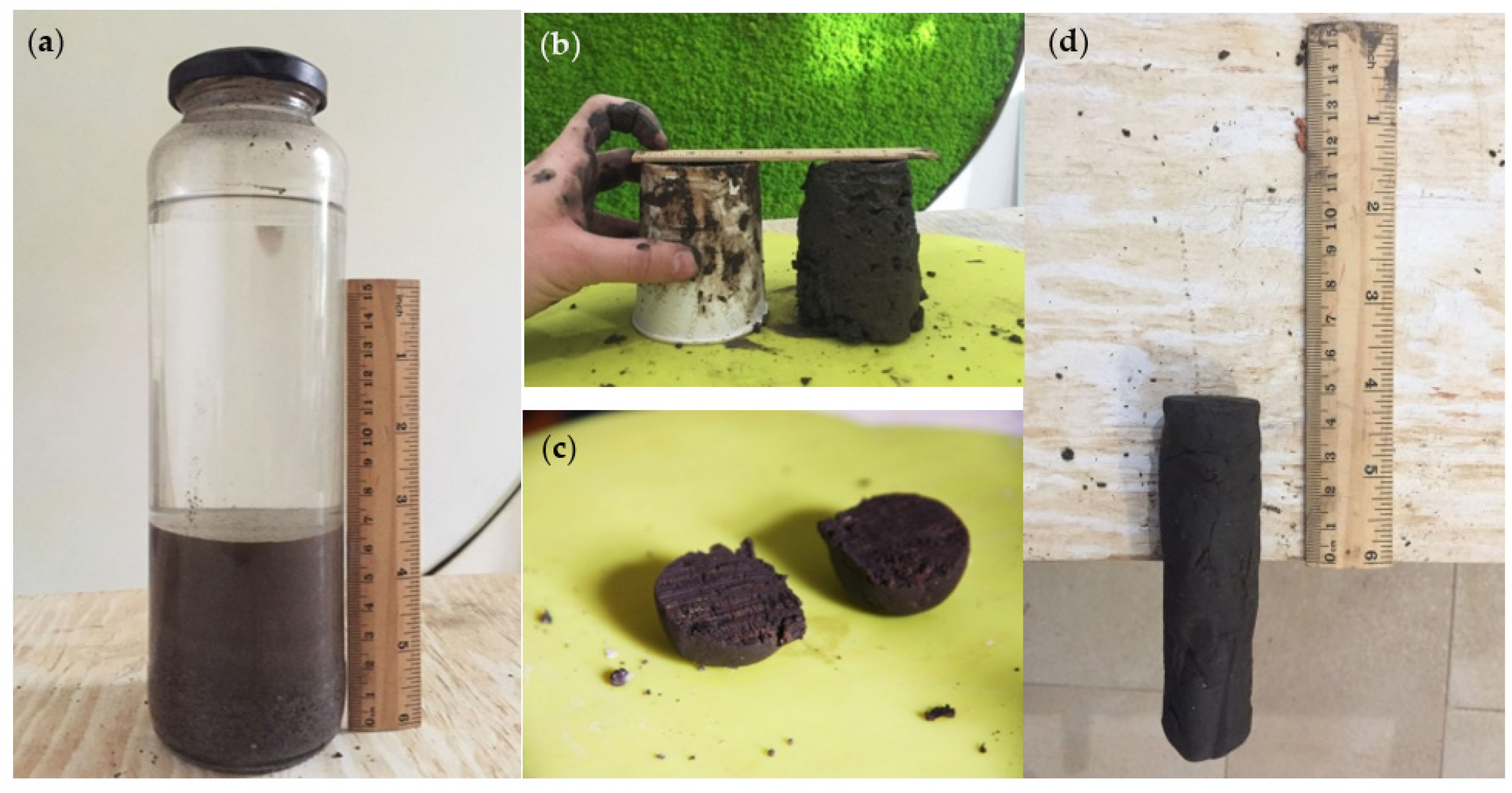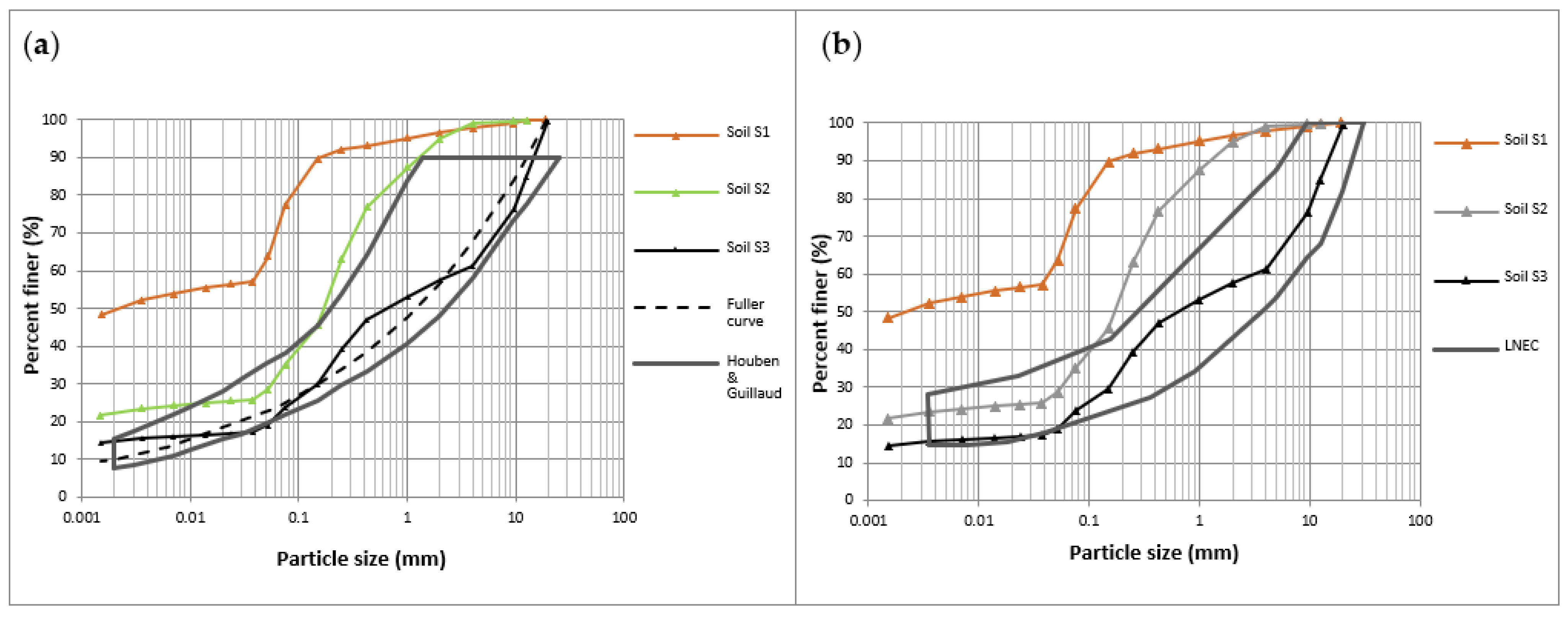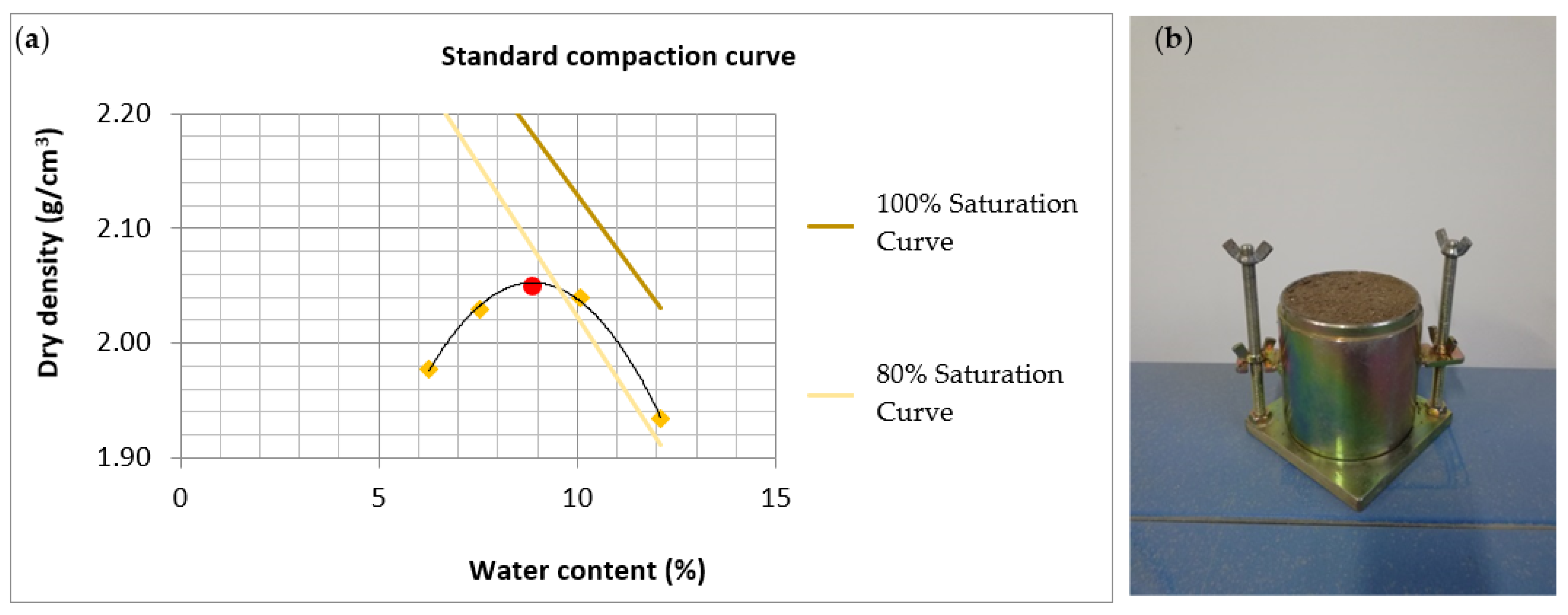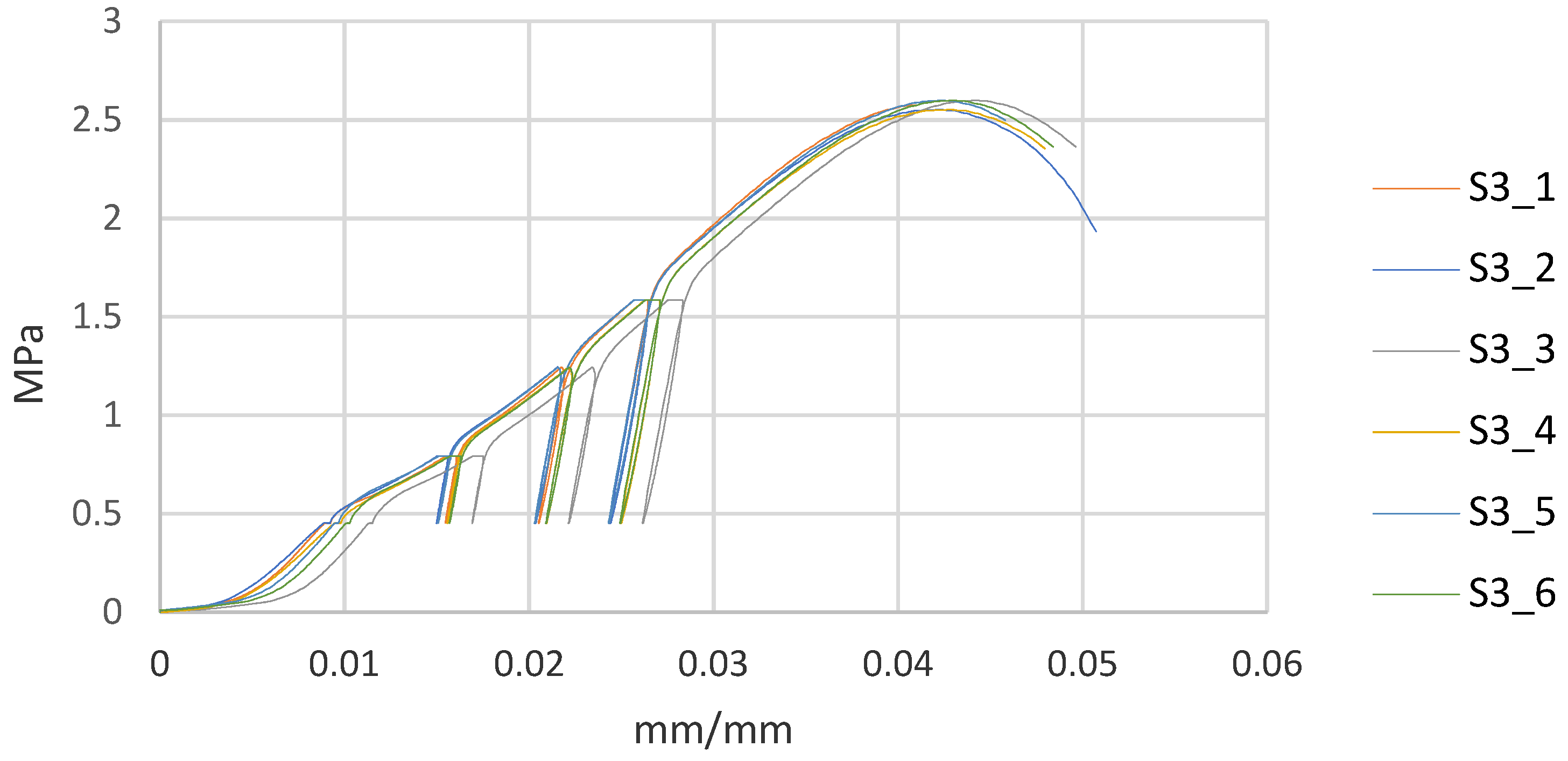Rammed Earth with Straw Fibers and Earth Mortar: Mix Design and Mechanical Characteristics Determination
Abstract
:1. Introduction
2. Materials and Methods
2.1. Preliminary Knowledge Analysis In Situ
2.2. Laboratory Analyses
2.2.1. Particle Size Analysis
2.2.2. Atterberg Limits
2.3. Rammed Earth Mix Design Characterization
2.3.1. Mix Design
2.3.2. Laboratory Tests: Proctor Test
2.3.3. Laboratory Tests: Realization of Specimens
2.3.4. Laboratory Tests: Simple Compressive Test
2.3.5. Laboratory Tests: Indirect Tensile (Brazilian) Test
2.3.6. Results Discussion
2.4. Earth Mortar Characterization
2.4.1. Mix Design
2.4.2. Laboratory Tests: Realization of the Specimens
2.4.3. Laboratory Tests: Evaluation of Linear and Volumetric Shrinkage
2.4.4. Laboratory Tests: Three-Points Bending Test
2.4.5. Laboratory Tests: Simple Compressive Test
2.4.6. Results Discussion
3. Conclusions
- Fibers would increase the ductility of earth elements and the consequent mechanical production and compaction methods for the specimens, as occurred for the pisé walls;
- The compaction method is reliable as the compressive strength values are very similar to each other and therefore constant, settling around a value consistent for the raw earth material;
- Due to the presence of straw in the earth mix, the tensile strength can be considered of interest for future studies, also taking into account the lack of data;
- The compatible earth mortar results comply and are consistent with all the requirements in terms of workability, linear shrinkage and mechanical characteristics.
Author Contributions
Funding
Data Availability Statement
Acknowledgments
Conflicts of Interest
References
- Galdieri, E. Le Meraviglie Dell’architettura in Terra Cruda; Editori Laterza: Bari, Italy, 1982. (In Italian) [Google Scholar]
- Houben, H.; Guillaud, H. Traité de Construction en Terre; Parentheses: Marseille, France, 2006. (In French) [Google Scholar]
- Guadagni, A. Prontuario Dell’ingegnere, 3rd ed.; Hoepli Editore: Milano, Italy, 2010. (In Italian) [Google Scholar]
- Anger, R.; Fontaine, L. Bȃtir en Terre. Du Grain de Sable à L’architecture; Belin: Paris, France, 2009. (In French) [Google Scholar]
- Houben, H.; Guillaud, H. Earth Construction: A Comprehensive Guide, 2nd ed.; Practical Action Publishing: Rugby, UK, 2008. [Google Scholar]
- Bertagnin, M. Il Pisé e La Regola; Alinea: Firenze, Italy, 1981. (In Italian) [Google Scholar]
- Bui, Q.B.; Morel, J.C.; Hans, S.; Meunier, N. Compression behaviour of non-industrial materials in civil engineering by three scale experiments: The case of rammed earth. Mater. Struct. 2009, 42, 1101–1116. [Google Scholar] [CrossRef]
- Plataforma Arquitectura. Available online: https://www.plataformaarquitectura.cl/cl/801069/25-manuales-de-autoconstruccion-diseno-y-arquitectura-participativa-en-mexico-parte-1?ad_medium=gallery (accessed on 5 February 2021).
- Vargas-Neumann, J. Earthquake resistant rammed earth (tapial) buildings. In Proceedings of the 7th International Conference on the Study and Conservation of Earthen Architecture TERRA 93, Silves, Portugal, 24–29 October 1993; pp. 140–151. [Google Scholar]
- Röhlen, U.; Ziegert, C. Lehmbau-Praxis: Planung und Ausfϋhrung, 3rd ed.; Beuth Praxis (Beuth Verlag GmbH): Berlin, Germany, 2020. (In German) [Google Scholar]
- New Zealand Standards: NZS 4297. In Engineering Design of Earth Buildings; Standards New Zealand; The trading arm of theStandards Council: Wellington, New Zealand, 1998.
- New Zealand Standards: NZS 4298. In Materials and Workmanship for Earth Building; Standards New Zealand; The trading arm of theStandards Council: Wellington, New Zealand, 1998.
- Jaquin, P.A.; Augarde, C.E.; Gerrard, C.M. Analysis of Historic Rammed Earth construction. In Proceedings of the 5th International Conference on Structural Analysis of Historical Constructions SAHC 2006, New Delhi, India, 6–8 November 2006; pp. 1091–1098. [Google Scholar]
- Jaquin, P.A.; Augarde, C.E.; Gerrard, C.M. Historic rammed earth structures in Spain: Construction techniques and a preliminary classification. In Proceedings of the International Symposium on Earthen Structures, Bangalore, India, 22–24 August 2007; pp. 327–333. [Google Scholar]
- Dierks, K.; Ziegert, C. Kapelle der Versöhnung—Schlussbericht zur Fremdϋberwachtung Forschungs– und Seminarbericht des Fachgebietes Tragwerkslehre und Baukonstruktion der TU Berlin. 2000. (In German). Available online: https://www.tek.tu-berlin.de/menue/forschung/lehmbau/ (accessed on 17 January 2021).
- Bui, T.T.; Bui, Q.B.; Limam, A.; Maximilien, S. Failure of rammed earth walls: From observations to quantifications. Constr. Build. Mater. 2014, 51, 295–302. [Google Scholar] [CrossRef] [Green Version]
- Hall, M.; Djerbib, Y. Rammed earth sample production: Context, recommendations and consistency. Constr. Build Mater. 2014, 18, 281–286. [Google Scholar] [CrossRef]
- Lilley, D.M.; Robinson, J. Ultimate strength of rammed earth walls with openings. Proceedings of the Institution of Civil Engineers (ICE). Struct. Build. 1995, 110, 278–287. [Google Scholar] [CrossRef]
- Maniatidis, V.; Walker, P.; Heath, A.; Hayward, S. Mechanical and thermal characteristics of rammed earth. In Proceedings of the International symposium on Earthen Structures, Bangalore, India, 22–24 August 2007; pp. 205–211. [Google Scholar]
- Maniatidis, V.; Walker, P. Structural capacity of rammed earth in compression. J. Mater. Civil. Eng. 2008, 20, 230–238. [Google Scholar] [CrossRef]
- Miccoli, L.; Mϋller, U. Characterization of earthen materials. A comparison between earth block masonry, rammed earth and cob. In Proceedings of the 8th International conference on Structural Analysis of Historical Constructions SAHC 2012, Wroclaw, Poland, 15–17 October 2012; pp. 841–849. [Google Scholar]
- Miccoli, L.; Mϋller, U.; Fontana, P. Mechanical behaviour of earthen materials: A comparison between earth block masonry, rammed earth and cob. Constr. Build Mater. 2014, 61, 327–339. [Google Scholar] [CrossRef]
- Romanazzi, A.; Oliveira, D.V.; Silva, R.A. Experimental Investigation on the Bond Behavior of a Compatible TRM-based solution for rammed earth heritage. Int. J. Archit. Herit. 2019, 19, 1042–1060. [Google Scholar] [CrossRef]
- Yamín Lacouture, L.E.; Phillips Bernal, C.; Reyes Ortiz, J.C.; Ruiz Valencia, D. Estudios de vulnerabilidad sismica rehabilitacion y refuerzo de casas en adobe y tapia pisada. Apunt. Rev. Estud. Sobre Patrim. Cult. J. Cult. Herit. Stud. 2007, 20, 286–303. (In Spanish) [Google Scholar]
- De Felice, G.; De Santis, S.; Garmendia, L.; Ghiassi, B.; Larrinaga, P.; Lourenço, P.B.; Oliveira, D.V.; Fabrizio Paolacci, F.; Papanicolaou, C.G. Mortar-based systems for externally bonded strengthening of masonry. Mater. Struct. 2014, 47, 2021–2037. [Google Scholar] [CrossRef]
- Borri, A.; Corradi, M. FRP: Fiber Reinforced Polymers. I Materiali Innovativi Nell’edilizia e Nel Restauro; Recupero e Conservazione; De Lettera: Milano, Italy, 2001. (In Italian) [Google Scholar]
- Torrealva, D. Static and dynamic testing for validating the polymer grid as external reinforcement in earthen buildings. In Proceedings of the 16th International Brick and Block Masonry Conference, Padova, Italy, 26–30 June 2016. [Google Scholar]
- Fagone, M.; Loccarini, F.; Ranocchiai, G. Strength evaluation of jute fabric for the reinforcement of rammed earth structures. Compos. Part B Eng. 2017, 133, 1–13. [Google Scholar] [CrossRef]
- Figueiredo, A.; Varum, H.; Costa, A.; Silveira, D.; Oliveira, C. Seismic retrofitting solution of an adobe masonry wall. Mater. Struct. 2013, 46, 203–219. [Google Scholar] [CrossRef] [Green Version]
- Gomes, M.I.; Gonçalves, T.D.; Faria, P. The compatibility of earth-based repair mortars with rammed earth substrates. In Proceedings of the 3rd Historic Mortars Conference HMC13, Glasgow, UK, 11–14 September 2013. [Google Scholar]
- Van Gorp, M.; Verstrynge, E.; Oliveira, D.V.; Silva, R.A.M.; Romanazzi, A. Experimental Study of the In-Plane Behavior of Rammed Earth, Strengthened with TRM. 2019. Available online: http://hdl.handle.net/1822/69268 (accessed on 17 January 2021).
- Silva, R.A.; Oliveira, D.V.; Schueremans, L.; Miranda, T.; Machado, J. Shear behaviour of rammed earth walls repaired by means of grouting. In Proceedings of the 9th International Masonry Conference 2014 9IMC, Guimarães, Portugal, 7–9 July 2014. [Google Scholar]
- Domínguez Martínez, O. Preservation and Repair of Rammed Earth Constructions. Master’s Thesis, Universidade do Minho, Braga, Portugal, 14 July 2015. [Google Scholar] [CrossRef]
- Atzeni, C.; Achenza, M.; Sanna, U.; Mocci, S. Il Manuale Tematico Della Terra Cruda; Libreria dei tipografi del genio civile: Roma, Italy, 2008. (In Italian) [Google Scholar]
- ASTM D422: Standard Test Method for Particle-Size Analysis of Soils, American Society for Testing and Materials; Withdrawn 2016; (ASTM) International: West Conshohocken, PA, USA, 2007.
- ASTM D2487: Standard Practice for Classification of Soils for Engineering Purposes (USCS: Unified Soil Classification System); American Society for Testing and Materials (ASTM) International: West Conshohocken, PA, USA, 2017.
- Casagrande, A. The determination of pre-consolidation load and it’s practical significance. Proc. Int. Conf. Soil Mech. Found. Eng. Cambridge Mass. 1936, 3, 60. [Google Scholar]
- ASTM D4318: Standard Test Methods for Liquid Limit, Plastic Limit, and Plasticity Index of Soils; American Society for Testing and Materials (ASTM) International: West Conshohocken, PA, USA, 2017.
- Minke, G. Building with Earth: Design and Technology of a Sustainable Architecture; Birkhäuser-De Gruyter: Basel, Germany, 2006. [Google Scholar]
- Fuller, W.B.; Thomson, S.E. The Laws of Proportioning Concrete. Trans. Am. Soc. Civ. Eng. 1907, 59, 67–143. [Google Scholar] [CrossRef]
- Viñuales, G.M.; Martins Neves, C.M.; Flores, M.O.; Ríos, L.S. Arquitecturas de Tierra en Iberoamérica, Habiterra; Buenos Aires Libros: Buenos Aires, Argentina, 2003. (In Spanish) [Google Scholar]
- Harmonized standard for Rammed Earth Structures: Code of Practice (SADCSTAN TC 1/SC 5/CD SAZS 724); African Organisation for Standardisation: Nairobi, Kenya, 2014.
- Doat, P.; Hays, A.; Houben, H.; Matuk, S.; Vitoux, F. Building with Earth (CRATerre, France); The Mud Village Society: New Delhi, India, 1991. [Google Scholar]
- Houben, H.; Guillaud, H. Earth Construction: A Comprehensive Guide Technology, 1st ed.; ITDG Publishing: London, UK, 2004. [Google Scholar]
- LNEC. O Uso da Terra Como Material de Construção; Laboratório Nacional de Engenharia Civil: Lisbon, Portugal, 1953. (In Portuguese) [Google Scholar]
- Walker, P.; Keable, R.; Martin, J.; Maniatidis, V. Rammed Earth, Design and Construction Guidelines; BRE Press: Watford, UK, 2005. [Google Scholar]
- Röhlen, U.; Volhard, F. Lehmbau Regeln: Begriffe, Baustoffe, Bauteile, 3rd ed.; Springer Vieweg Verlag: Berlin, Germany, 2009. (In German) [Google Scholar]
- Gonzalo, B.R.; Pilar, B.B. Monografías de la Direccioón General para la Vivienda y Arquitectura. In Bases Para el Diseno y Construccion con Tapial; Centro de Publicaciones: Madrid, Spain, 1992. [Google Scholar]
- Instituto de Ciencias de la Construcción Eduardo Torroja, Madrid, Spagna. Available online: http://www.ietcc.csic.es/ (accessed on 17 January 2021).
- Walker, P. Standards Australia. In The Australian Earth Building Handbook; HB 195-2002; Standards Australia International: Sydney, Australia, 2002. [Google Scholar]
- ASTM D698: Standard Test Methods for Laboratory Compaction Characteristics of Soil Using Standard Effort; American Society for Testing and Materials (ASTM) International: West Conshohocken, PA, USA, 2012.
- Vargas, J.; Bariola, J.; Blondet, M. Seismic strength of adobe masonry. Mater. Struct. 1986, 19, 253–258. [Google Scholar] [CrossRef]
- Scudo, G.; Narici, B.; Talamo, C. Costruire Con La Terra. Tecniche Costruttive, Campi di Utilizzo e Prestazioni; Editori Esselibri: Napoli, Italy, 2001. (In Italian) [Google Scholar]
- UNI EN 12390-6:2010. In Testing Hardened Concrete-Part 6: Tensile Splitting Strength of Test Specimens; European Standard; BSI: London, UK, 2019.
- UNI EN 1015-11:2019. In Methods of Test for Mortar for Masonry-Part 11: Determination of Flexural and Compressive Strength of Hardened Mortar; European Standard; BSI: London, UK, 2019.
- UNI EN 12390-3:2019. In Testing Hardened Concrete-Part 3: Compressive Strength of Test Specimens; European Standard; BSI: London, UK, 2019.
- Barroso, A. Reforço Sìsmico Inovador de Construção de Taipa. Msc Thesis, Universidade do Minho, Guimarães, Portugal, 2017. [Google Scholar]














| Reference | Bulk Density (kg/m3) | Compressive Strength (MPa) | Young’s Modulus (MPa) |
|---|---|---|---|
| NZS 4297- NZS 4298 (1998) [11,12] | nd | >1.30 | E = 300 fc |
| P. Jaquin et al. (2006–2007) [13,14] | nd | 0.60–0.70 | 60 |
| U. Röhlen et al. (2010) [10] | 1700–2400 | 1.50–4.00 | 750 |
| K. Dierks et al. (2000) [15] | 2100–2300 | 2.40–3.00 | 650 |
| Q. Bui et al. (2014) [16] | 1800 | 1.00 | 90–105 |
| M. Hall et al. (2014) [17] | 2020–2160 | 0.75–1.46 | nd |
| D.M. Lilley et al. (1995) [18] | 1870–2170 | 1.80–2.00 | nd |
| V. Maniatidis et al. (2007) [19] | 1850 | 3.88 | 205 |
| V. Maniatidis et al. (2008) [20] | 1850 | 2.46 | 160 |
| L. Miccoli et al. (2012–2014) [21,22] | 2190 | 3.73 | 4143 |
| A. Romanazzi et al. (2019) [23] | 2080 | 1.50 | 471 |
| L. Lacouture et al. (2007) [24] | 1930 | 0.60 | 67 |
| Reference | Bulk Density (kg/m3) | Compressive Strength (MPa) | Young’s Modulus (MPa) |
|---|---|---|---|
| NZS4297–NZS4298 (1998) [11,12] | nd | >1.30 | E = 300 fc |
| M. Van Gorp (2017–2018) [31] | 2140 | 1.40 | 453 |
| Silva et al. (2014) [32] | 1830 | 1.26 | 1034 |
| A. Romanazzi et al. (2019) [23] | 2130 | 1.50 | 471 |
| M. Hall et al. (2014) [17] | 2020–2160 | 0.75–1.46 | nd |
| D.M. Lilley (1995) [18] | 1870–2170 | 1.80–2.00 | nd |
| V. Maniatidis et al. (2007) [19] | 1850–2100 | 2.88 | 205 |
| V. Maniatidis (2008) [20] | 1850–2100 | 2.46 | 160 |
| Domínguez Martínez (2015) [33] | 2210 | 1.50 | 536 |
| Reference | Clay | Lime | Sand | Gravel | Sand + Gravel |
|---|---|---|---|---|---|
| Füller (1997) [40] | 10% | 14% | 33% | 43% | 76% |
| Van Gorp (2018) [31] | 12% | 13% | 34% | 41% | 75% |
| Houben & Guillaud (2004) [44] | 8–16% | 13–21% | - | - | - |
| Architecturas de terra en Iberoamérica (2003) [41] | 20–30% | - | - | - | 60–80% |
| P. Walker (2005) [46] | 5–20% | 10–30% | - | - | 45–80% |
| Lehmbau Regeln (2009) [47] | 15% | 30% | 15% | 40% | 55% |
| MOPT (1992) [48] | 5–16% | - | - | - | - |
| IETcc (1971) [49] | 10–40% | 20–40% | 10–40% | 10–20% | - |
| Code of Practice SADCSTAN [42] | 5–15% | 15–30% | - | - | 50–70% |
| Standards Australia (2002) [50] | 5–20% | 10–30% | - | - | 45–75% |
| Miccoli et al. (2014) [22] | 11% | 25% | - | - | 64% |
| Doat et al. (1991) [43] | 15–18% | 10–28% | - | - | 55–75% |
| S3 | 16% | 7% | 42% | 35% | - |
| N° Specimens | Compressive Strength (MPa) | Young’s Modulus E (MPa) |
|---|---|---|
| S3_1 | 2.48 | 65 |
| S3_2 | 2.67 | 67 |
| S3_3 | 2.59 | 78 |
| S3_4 | 2.47 | 69 |
| S3_5 | 2.58 | 75 |
| S3_6 | 2.67 | 70 |
| Mean Value | 2.58 | 71 |
| Standard Deviation (–) | 0.08 | 4.49 |
| Relative Standard Deviation (%) | 3.10% | 6.32% |
| N° Specimens | Tensile Strength fct (MPa) |
|---|---|
| S3_7 | 0.212 |
| S3_8 | 0.269 |
| Mean Value | 0.240 |
| Standard Deviation (–) | 0.028 |
| Relative Standard Deviation (%) | 11.67% |
| Specimen Characteristic S3 | Value |
|---|---|
| Dimensions | d = h = 150 mm |
| Wet weight | 6000 g |
| Wet density | 2.28 g/cm3 |
| Maximum dry density | 2.07 g/cm3 |
| Compressive strength | 2.58 MPa |
| Young’s modulus (E) | 71 MPa |
| Tensile strength | 0.24 MPa |
| Internal friction angle () | 56° |
| Cohesion (c) | 0.39 MPa |
| Mix Design | Earth | Sand | Clay |
|---|---|---|---|
| S1 | 100% | 0% | 49% |
| M1 | 30% | 70% | 21% |
| M2 | 25% | 75% | 16% |
| M3 | 20% | 80% | 12% |
| M4 | 15% | 85% | 9% |
| N° Specimens | Shrinkage (mm) | |||
|---|---|---|---|---|
| ΔL1 | ΔL2 | ΔH | ΔV | |
| M1_1 | 3.6 | 1.5 | 1.6 | 7.7 |
| M1_2 | 3.3 | 1.6 | 1.6 | 7.9 |
| M1_3 | 3.1 | 1.3 | 1.5 | 7.3 |
| Mean Value M1 | 3.33 (2.1%) | 1.47 (3.7%) | 1.57 (3.9%) | 7.63 |
| Standard Deviation M1 | 0.21 | 0.12 | 0.05 | 0.25 |
| M2_1 | 3.8 | 1.0 | 1.2 | 6.0 |
| M2_2 | 0.9 | 1.1 | 1.2 | 3.2 |
| M2_3 | 0.8 | 1.1 | 1.2 | 3.1 |
| Mean Value M2 | 1.83 (1.1%) | 1.07 (2.7%) | 1.2 (3.0%) | 4.1 |
| Standard Deviation M2 | 1.39 | 0.05 | 0 | 1.34 |
| M3_1 | 0.6 | 0.7 | 0.6 | 1.9 |
| M3_2 | 0.7 | 0.8 | 0.7 | 2.2 |
| M3_3 | 0.5 | 0.6 | 0.5 | 1.6 |
| Mean Value M3 | 0.60 (0.4%) | 0.70 (1.8%) | 0.60 (1.5%) | 1.90 |
| Standard Deviation M3 | 0.08 | 0.08 | 0.08 | 0.24 |
| M4_1 | 0.5 | 0.6 | 0.5 | 1.6 |
| M4_2 | 0.6 | 0.5 | 0.5 | 1.6 |
| M4_3 | 0.4 | 0.5 | 0.5 | 1.4 |
| Mean Value M4 | 0.50 (0.3%) | 0.53 (1.3%) | 0.5 (1.3%) | 1.53 |
| Standard Deviation M4 | 0.08 | 0.05 | 0.00 | 0.09 |
| N° Specimens | Compressive Strength fc (MPa) | Bending Strength fct (MPa) | |
|---|---|---|---|
| M1_1 | 1.88 | 3.13 | 0.91 |
| M1_2 | 2.65 | 3.07 | 0.87 |
| M1_3 | 2.13 | 1.97 | 0.98 |
| Mean Value M1 | 2.47 | 0.92 | |
| Standard Deviation M1 | 0.51 | 0.05 | |
| M2_1 | 1.79 | 1.23 | 0.60 |
| M2_2 | 1.89 | 1.25 | 0.69 |
| M2_3 | 1.70 | 1.90 | 0.61 |
| Mean Value M2 | 1.63 | 0.63 | |
| Standard Deviation M2 | 0.28 | 0.04 | |
| M3_1 | 1.33 | 1.11 | 0.51 |
| M3_2 | 1.80 | 1.50 | 0.55 |
| M3_3 | 1.27 | 1.52 | 0.43 |
| Mean Value M3 | 1.42 | 0.50 | |
| Standard Deviation M3 | 0.22 | 0.05 | |
| M4_1 | 0.92 | 1.13 | 0.47 |
| M4_2 | 0.95 | 0.91 | 0.43 |
| M4_3 | 0.71 | 1.16 | 0.35 |
| Mean Value M4 | 0.96 | 0.42 | |
| Standard Deviation M4 | 0.15 | 0.05 | |
Publisher’s Note: MDPI stays neutral with regard to jurisdictional claims in published maps and institutional affiliations. |
© 2021 by the authors. Licensee MDPI, Basel, Switzerland. This article is an open access article distributed under the terms and conditions of the Creative Commons Attribution (CC BY) license (https://creativecommons.org/licenses/by/4.0/).
Share and Cite
Sabbà, M.F.; Tesoro, M.; Falcicchio, C.; Foti, D. Rammed Earth with Straw Fibers and Earth Mortar: Mix Design and Mechanical Characteristics Determination. Fibers 2021, 9, 30. https://0-doi-org.brum.beds.ac.uk/10.3390/fib9050030
Sabbà MF, Tesoro M, Falcicchio C, Foti D. Rammed Earth with Straw Fibers and Earth Mortar: Mix Design and Mechanical Characteristics Determination. Fibers. 2021; 9(5):30. https://0-doi-org.brum.beds.ac.uk/10.3390/fib9050030
Chicago/Turabian StyleSabbà, Maria Francesca, Mariateresa Tesoro, Cecilia Falcicchio, and Dora Foti. 2021. "Rammed Earth with Straw Fibers and Earth Mortar: Mix Design and Mechanical Characteristics Determination" Fibers 9, no. 5: 30. https://0-doi-org.brum.beds.ac.uk/10.3390/fib9050030






